SPACE January 2024 (No. 674)
From the 22th of September to the 1st of October 2023, the exhibition ‘La Mercé de Picasso’ was held to commemorate the 50th anniversary of Pablo Picasso’s death. The exhibition venue, located in Barcelona’s Plaça de la Mercé, featured a structure with a white background, yet no artworks were visible. The site once housed the house where Picasso spent his early adulthood, but the buildings have since been demolished. A lively festival takes place every year at the end of September, but during regular times, the vacant land is left neglected. Plaça de la Mercé holds a variety of layered memories. Daniel Oh (professor, Korea University) believes that the collective memory of public spaces can connect communities, using AR (augmented reality) technology to summon accumulated memories and inject new ones. SPACE explores his story, delving into the new possibilities of architecture through the technology of AR and immersive urban experiences.
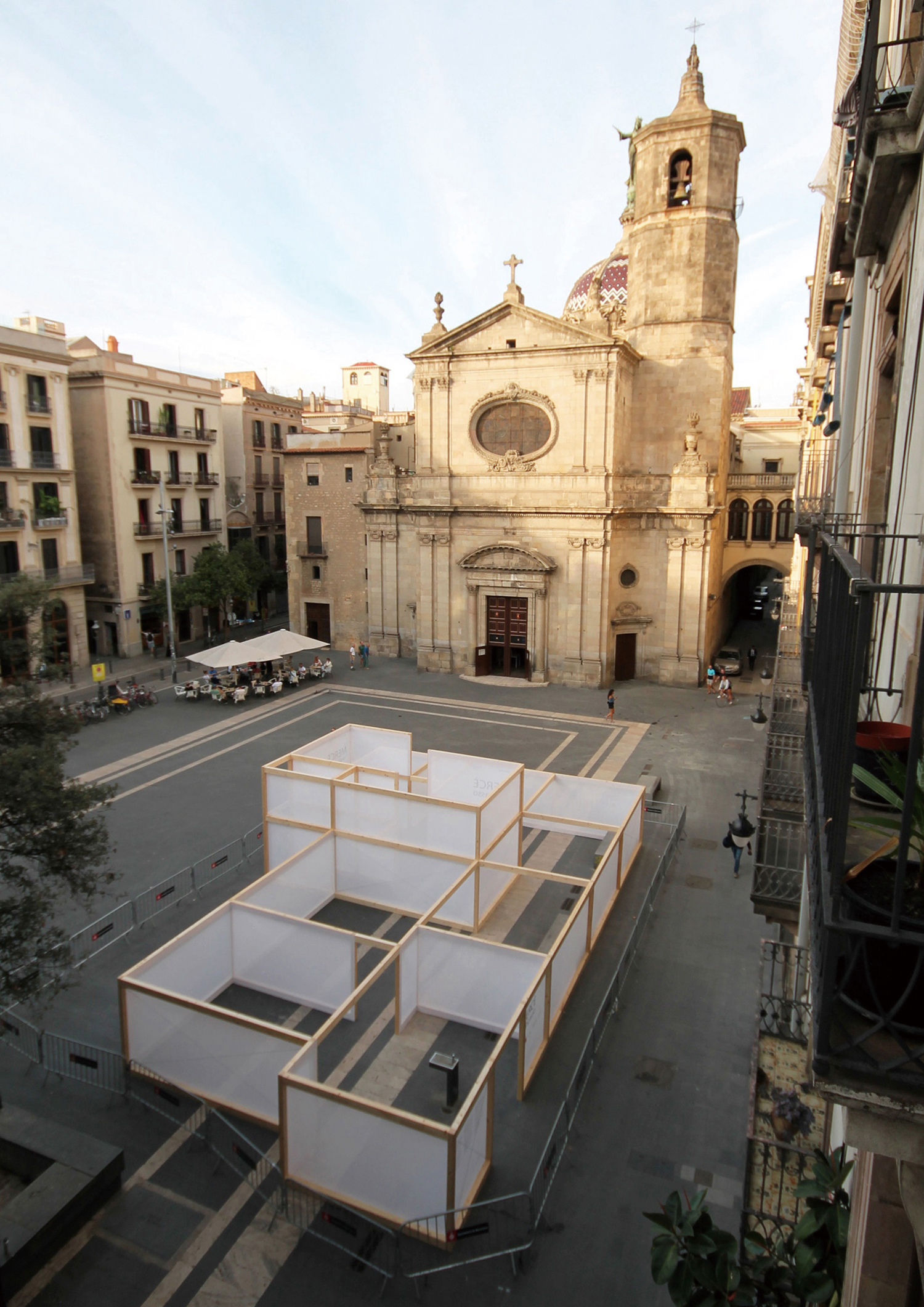
View of Plaça de la Mercé with the exhibition pavilion
Discovering Lost Collective Memory
Today, Plaça de la Mercé is known for hosting Barcelona’s oldest local festival, La Mercé, which draws two million visitors every year. However, for the rest of the year the square tends to be underused and neglected. In recent years, the square has attracted an increased number of unlawful or uncivil activities, especially during the evenings.
An intriguing comment by a long-time resident changed my perception of this unassuming public open space. This plaza came into existence in 1981 when a block of five buildings was torn down as part of an urban renewal project intending to make room in this densely populated medieval area of the city. Moreover, one of the buildings is where Pablo Picasso (1881–1973) and his family lived. This was common knowledge among older residents who had spent their entire lives in the neighbourhood. However, this instance of collective memory failed to remain within the community across the generations and with the arrival of new residents. The destruction of the actual building expedited the loss of this memory.
For most people, this piece of information might have been just an interesting fact or a slice of urban anecdote. But, as an urban designer researching mechanisms to empower the local community through urban public space, the loss of such a significant memory or historical moment posed an interesting challenge: can Picasso’s experience of Barcelona 130 years ago inspire Barcelonians today?
A Sense of Belonging
Every individual builds their own unique image of where they live and the places they visit, regardless of how long or brief their stay. It is likely that you will have an increased sense of ownership associated with public spaces and neighbourhoods if you take possession of and share meaningful memories and relationships anchored within urban places. Many studies have shown that this sense of belonging plays an important role in building a safe and healthy community. Therefore, we should never stop making new connections and new memories associated with public spaces. Local festivals offer excellent opportunities to create and renew collective memories linked to public spaces. ‘La Mercé de Picasso’ is an exhibition which intends to seed rediscovered or newly established collective memories in Plaça de la Mercé. By pursuing this agenda, the exhibition hoped to aid local residents in achieving a renewed sense of ownership and belonging within the neighbourhood.
Picasso lived in the Gothic-quarter of Barcelona from the age of 13 through to the age of 22. The development of any adolescent person is highly influenced by their social and local environments: family, friends, school, neighbourhoods, and wider community. Taking a journey through time and space, the exact location where Picasso’s family once lived offers visitors the chance to explore the environment that shaped and inspired his intellect more than a century ago. Beginning at the turn of 1900 in Barcelona, a series of socio-political occurences have been layered to set the stage for the web of interconnected events and shifts that formed much of Picasso’s early adulthood.
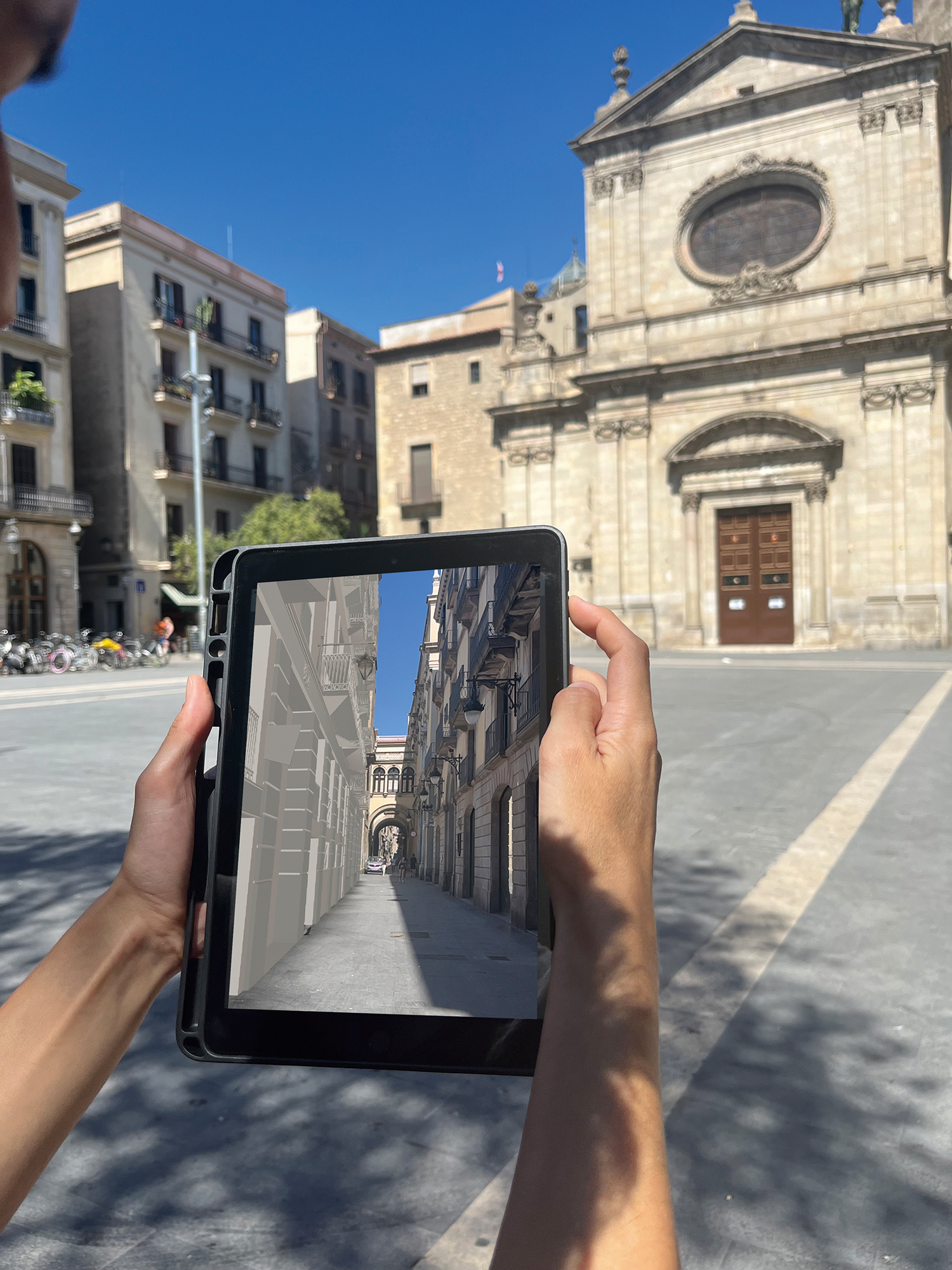
Visitors experience a virtual model of Carrer de la Mercé 3 reproduced in AR using location-based data.
Location-Based Cultural Content
AR technology has evolved significantly over the years, and the exhibition showcased some of the newest advancements, such as Google’s Geospatial Creator, which can pinpoint exactly where a device is by interpolating GPS signals with camera-based algorithmic data taken from nearby buildings. This technology allows commercially available handheld tablets to reproduce a virtual model of Carrer de la Mercé 3 and walk inside the digitally reconstructed building without additional sensors or expensive infrastructure.
The advantage of using AR expands to explore different ways of providing cultural content outside traditional cultural facilities. Placing an AR experience of Picasso family’s residence in the Plaça de la Mercé is like adding an ephemeral cultural layer to an existing public open space without substantial public investment or the construction of a new cultural venue. The exhibition contemplated the possibility of taking cultural content out of museums and moving it into public open space. As Picasso family’s residence is now an open public space, Plaça de la Mercé provides an ideal setting to situate the story of Picasso’s adolescent years anchored in their exact location. The potential of cultural experiences like this is enormous as immersive technologies continue to improve. However, from the very early stages, the project team made a conscious effort to depart from traditional content curation and to focus on developing a genuine ‘immersive experience’ in public space.
An Immersive Urban Experience
In addition to AR technology, the exhibition applied a serious games methodology to heighten the nature of the immersive experience through a series of interactions required of visitors. For example, the visitors were asked to press a button on the screen to approve or disapprove of the demolition of Carrer de la Mercé 3, where Picasso’s family lived. The button triggers the sound of demolition and a 3D model to simulate the group of buildings being knocked down, accompanied by a series of photographs showing the actual demolition of the buildings in 1981. Most visitors hesitated to press the ‘Yes’ or ‘No’ button and often engaged in brief debates; this was possible because visitors were considered participants through this gamification rather than as simply spectators of a narrative.
Perhaps architecture offered the most innovative aspect in the augmentation of the immersive digital experience. The exhibition successfully aligned the AR experience with the physical envelope representing Picasso family’s residence, significantly increasing the level of immersion, and hinting at new possibilities for architecture in the emerging era of new AR technology. The entire AR experience took place inside a temporary purpose-built structure. Of course, the AR experience does not need a physical structure to operate, however, it was necessary to introduce a pavilion for controlled access points and circulation, as well as providing a visual marker for visitors. The design of the pavilion followed the exact layout of Carrer de la Mercé 3
based on documentation and archival findings. Each segment of the AR experience was anchored to a specific location in the pavilion. The team worked with a timber fabricator to design a temporary structure that could be set up easily and disassembled to be stored away for future events. The outer perimeter was wrapped with a see-through mesh to retain visual permeability with the outside. The simple and minimal design of the pavilion intended to provide a backdrop for the experience rather than become a protagonist in the Plaça de la Mercé. Special attention was paid to way in which the pavilion would provide an ephemeral experience when visitors through the interior of the pavilion.
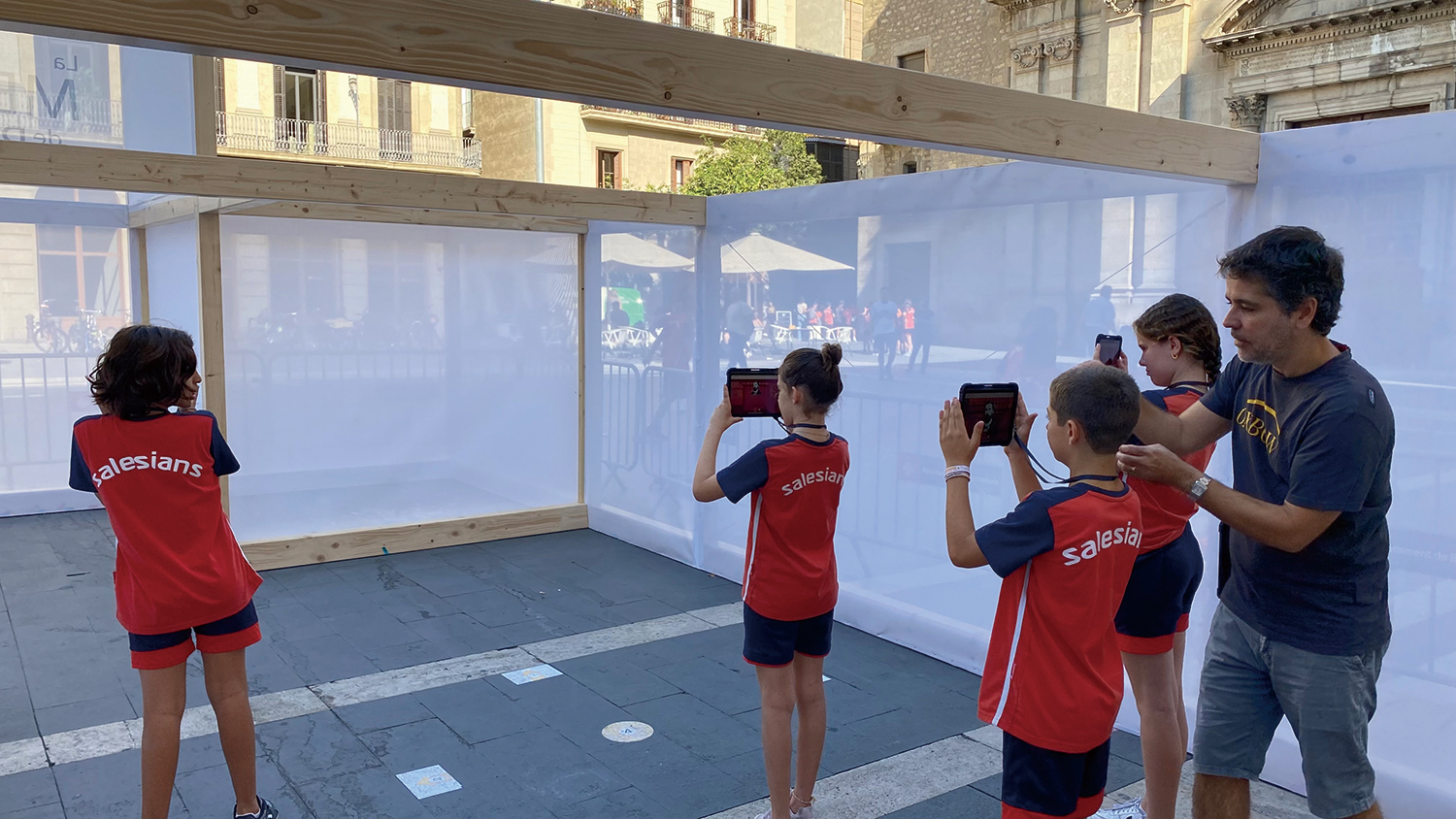
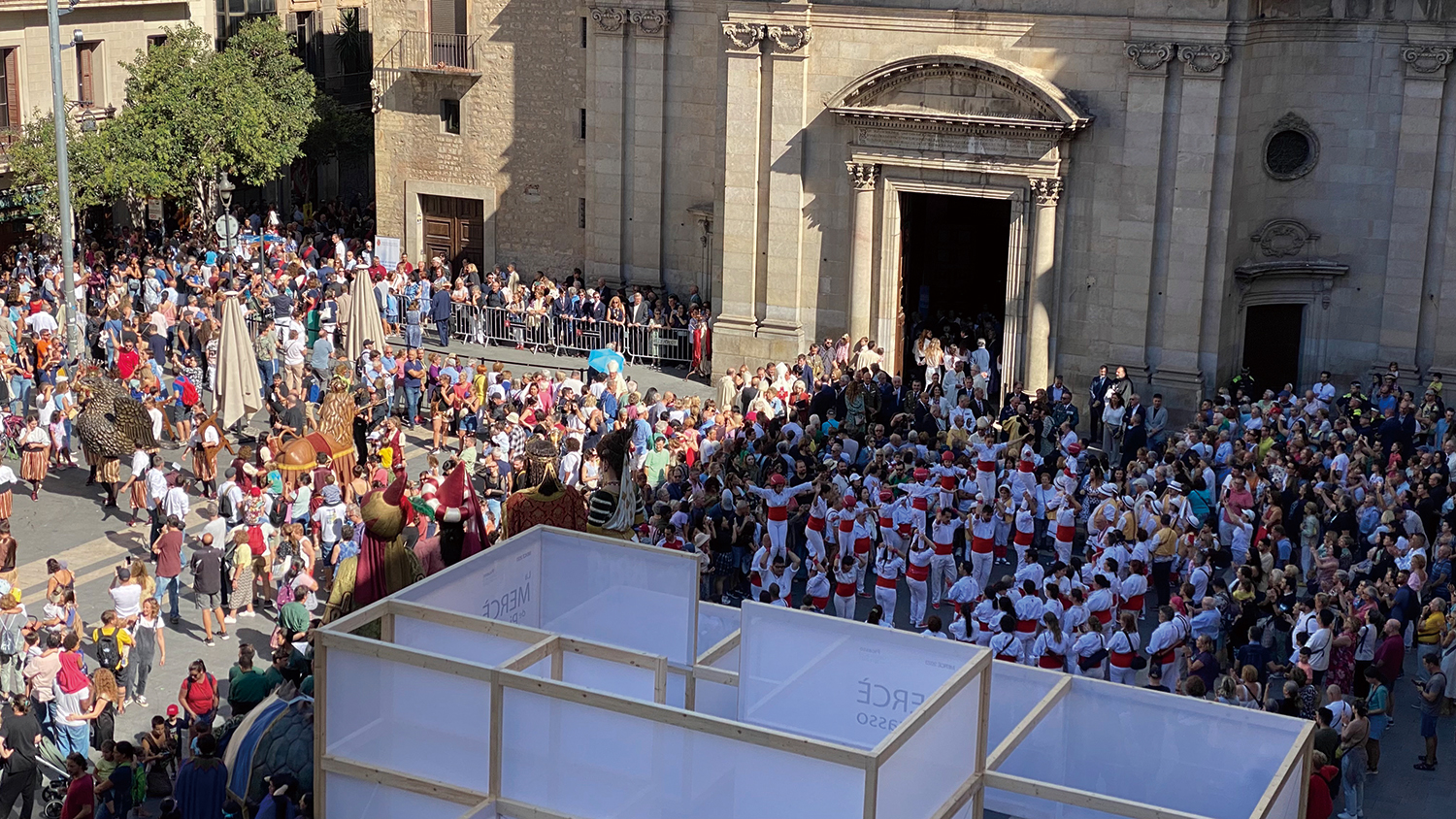
A Collaborative Future
Although AR technology has made a quantum leap since it was introduced more widely, numerous limitations still exist. The gap between technology and its real-world application seems to be the main hurdle, discouraging architects from investigating the full potential of this new technology. However, rather than focusing on its limitations, this exhibition offers a genuine lesson: from conception to execution, AR technology can inspire experts from different disciplines to explore what’s possible. Especially for a group of architects setting a new form of augmented value in motion within physical space, the technology serves as a platform to bond and challenge collaborators from outside of architecture. SquareMMKM is a group of architects and urbanists who have searched for ways of bringing new experiences and eclectic values to the built environment. The group have been experimenting with different ways of fusing technology and culture within physical space. We are proud of ourselves for initiating this transdisciplinary collaboration, made evident in this exhibition, ‘La Mercé de Picasso’.
Weaving Picasso’s family history and childhood story through the Plaça de la Mercé required scholarship, art historical knowledge and an understanding of Picasso. The Picasso Museum and Barcelona City Archive were a tremendous help as we embarked on our initial research. However, as interlopers in the art historical and curatorial communities, navigating the industry was almost impossible. We grossly underestimated the complexity of copyright and intellectual property laws and regulations. Without the help of Eduard Vallès Pallarès, the head of collections at the National Museum of Art of Catalonia, the project would not have been possible. Eduard immediately understood the importance of the project from cultural and urban perspectives. His professional and personal network also greatly assisted us in our activities. Assistance and support from the Picasso Museum and ICUB (Institut de Cultura de Barcelona) also allowed the exhibition to be part of two high-profile events. Their acknowledgment and faith in the project significantly boosted its visibility and credibility as a cultural venue.
Building the AR content posed the greatest challenge as multiple methods were available, depending on the level of interactivity and complexity of our visualisation. Moreover, balancing risks versus absolute necessities directly correlated with the cost of AR content building. From the early stages, we decided to concentrate on the narrative of the exhibition rather than building a custom-built extravagant UI (user interface). After considerable analysis and investigation, we settled on using a commercially available AR platform, greatly reducing the time and costs for our app development, and avoiding potential bugs and glitches. However, this compromise meant sacrificing some basic functions of AR technology. Additionally, developing the AR content required expertise from graphic designers and animators to make the content come alive.
The exhibition was never planned as a one-time event. The project team insisted that the ‘experiment’ should continue to embed layers of immersive location-based experiences. To accomplish this goal, the team brought together Basilica de la Mercé, university administration, artists’ associations, and large businesses located close to the plaza to form an alliance. The project team received rave reviews for bringing much-needed attention to the public space from residents and visitors alike. The art community, including the Circle of Artists and the Picasso Museum of Barcelona, welcomed this innovative way of overlaying cultural experience on public open space. Visitors appeared to cherish the experience of becoming better informed about a valuable urban memory; each person will have their own unique stories to tell every time they pass by the Plaça de la Mercé. Most importantly, people desire more urban experiences like this one; we are planning a follow-up exhibition in 2024 featuring Picasso’s childhood friends who roamed this Barcelona neighbourhood.
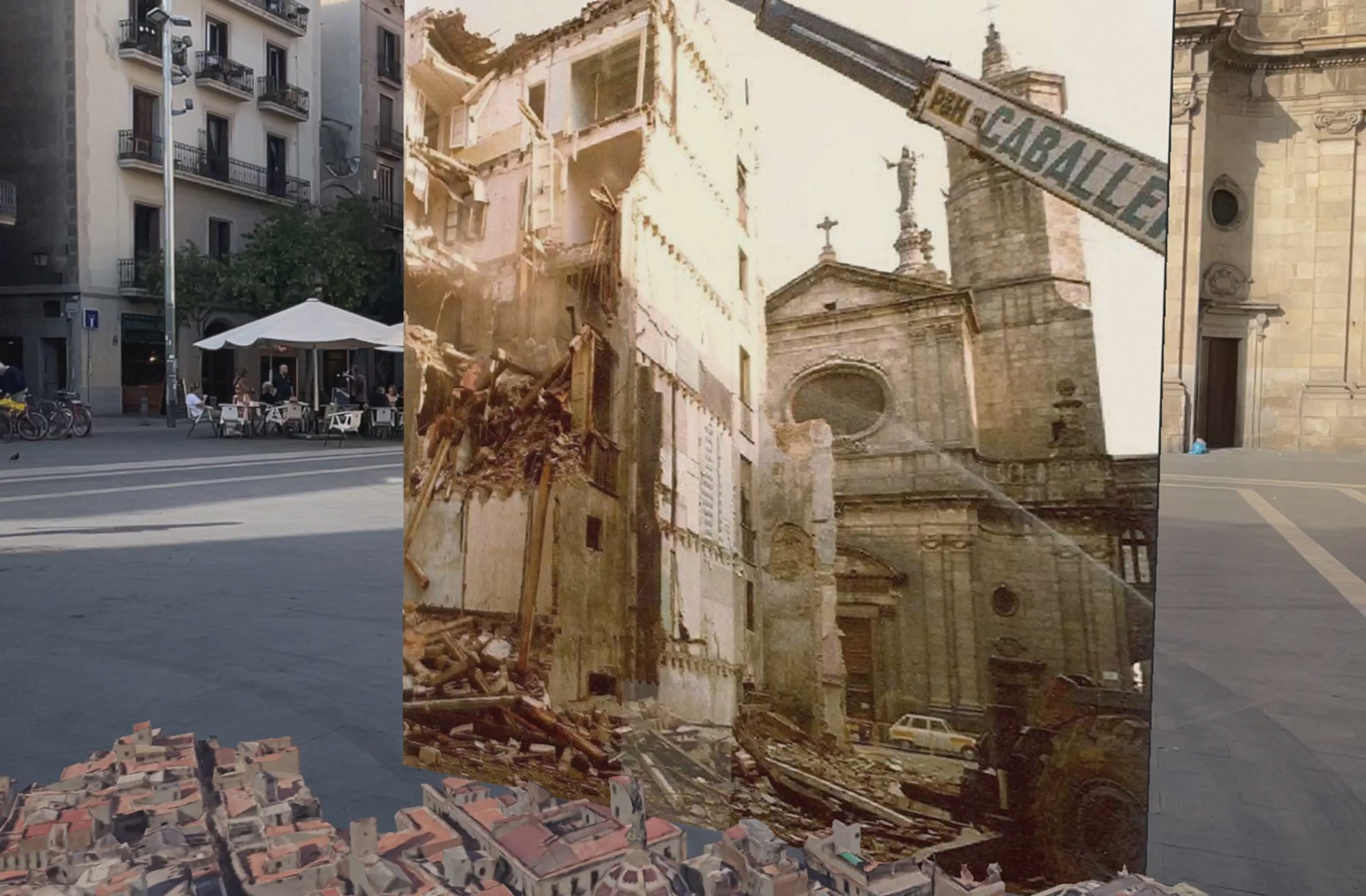
When visitors press a button on the screen to approve of the demolition, a 3D model to simulate buildings being knocked down, accompanied by photographs showing the actual demolition of the buildings in 1981.

Link to ‘La Mercé de Picasso’ website





